Autumn Flowers booklet
Issue Date: November 26, 2019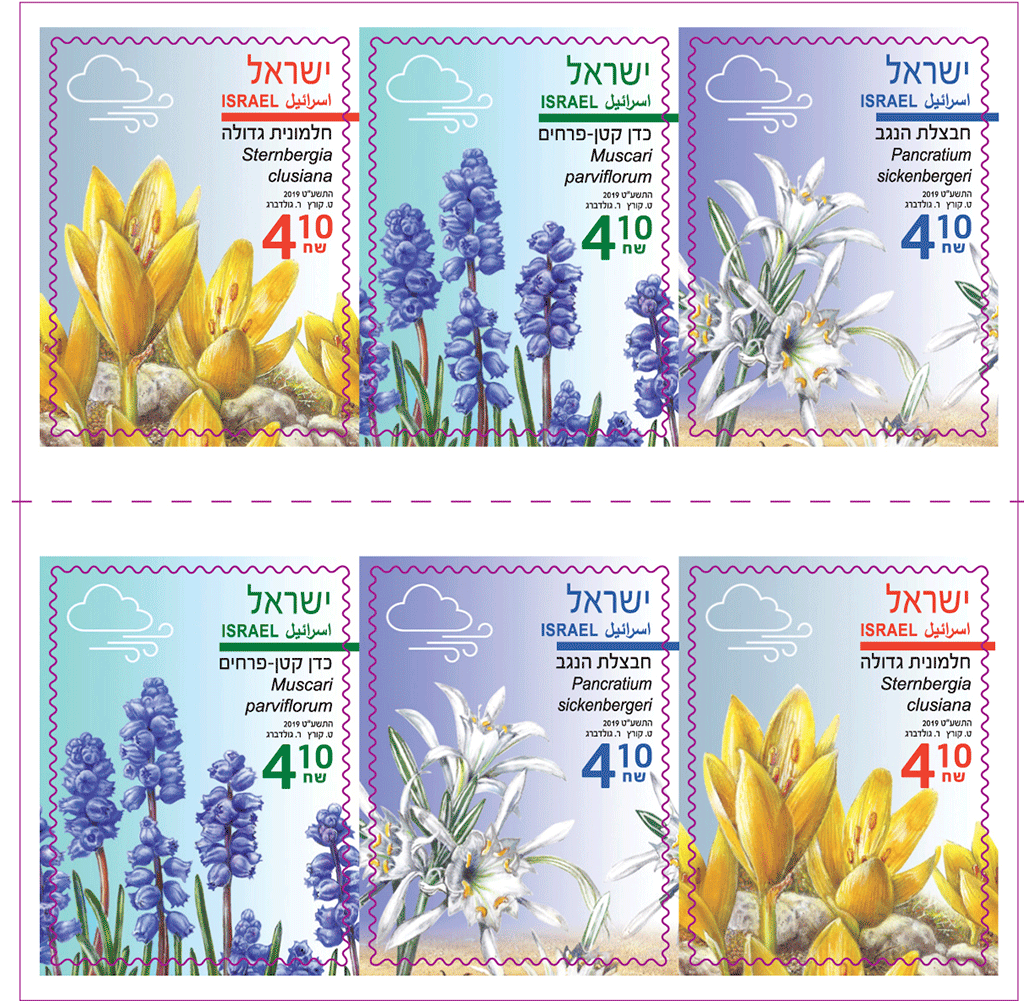
Denominations: Nis 24.60 (6 x 4.10)
Designers: Tuvia Kurtz & Ronen Goldberg
Printers: Tadbik, Israel
Booklet cover: 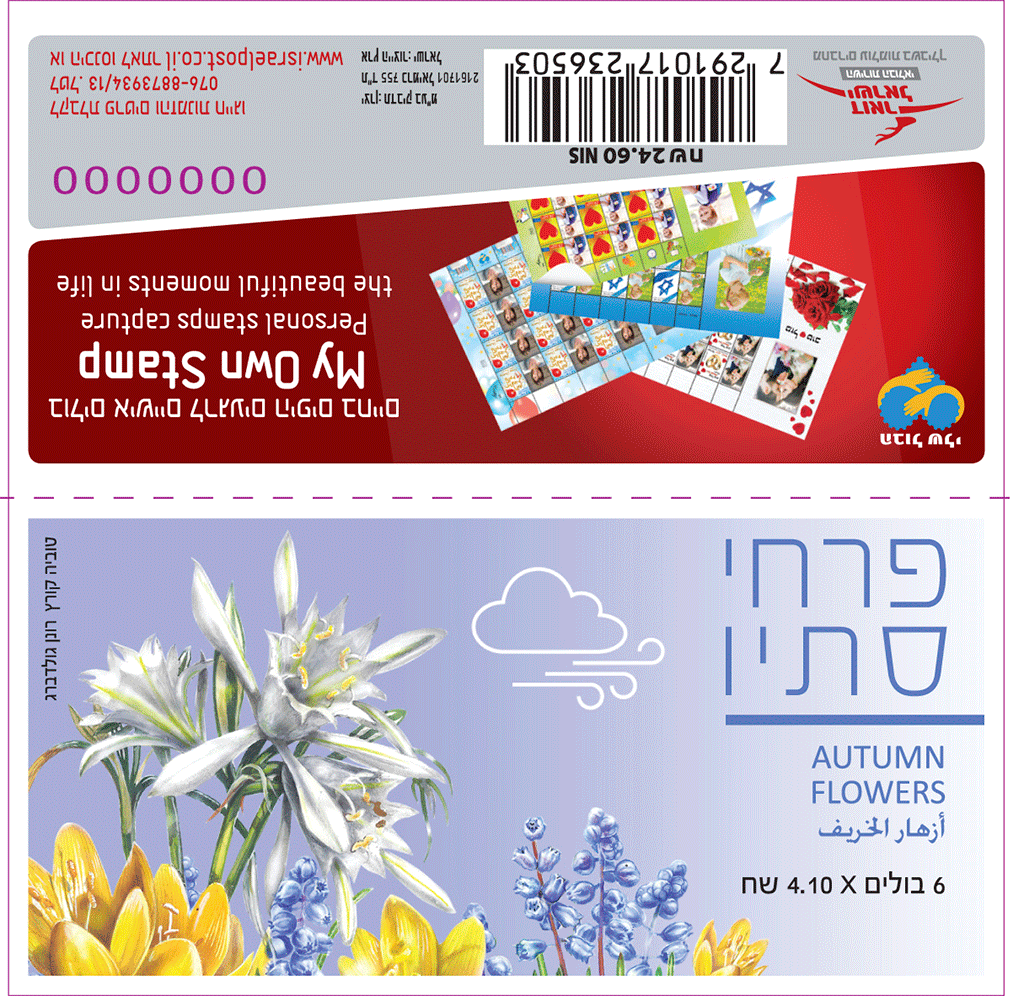

Autumn Flowers booklet
Issue Date: November 26, 2019
Denominations: Nis 24.60 (6 x 4.10)
Designers: Tuvia Kurtz & Ronen Goldberg
Printers: Tadbik, Israel
Booklet cover: 
Monsters
Issue Date: November 26th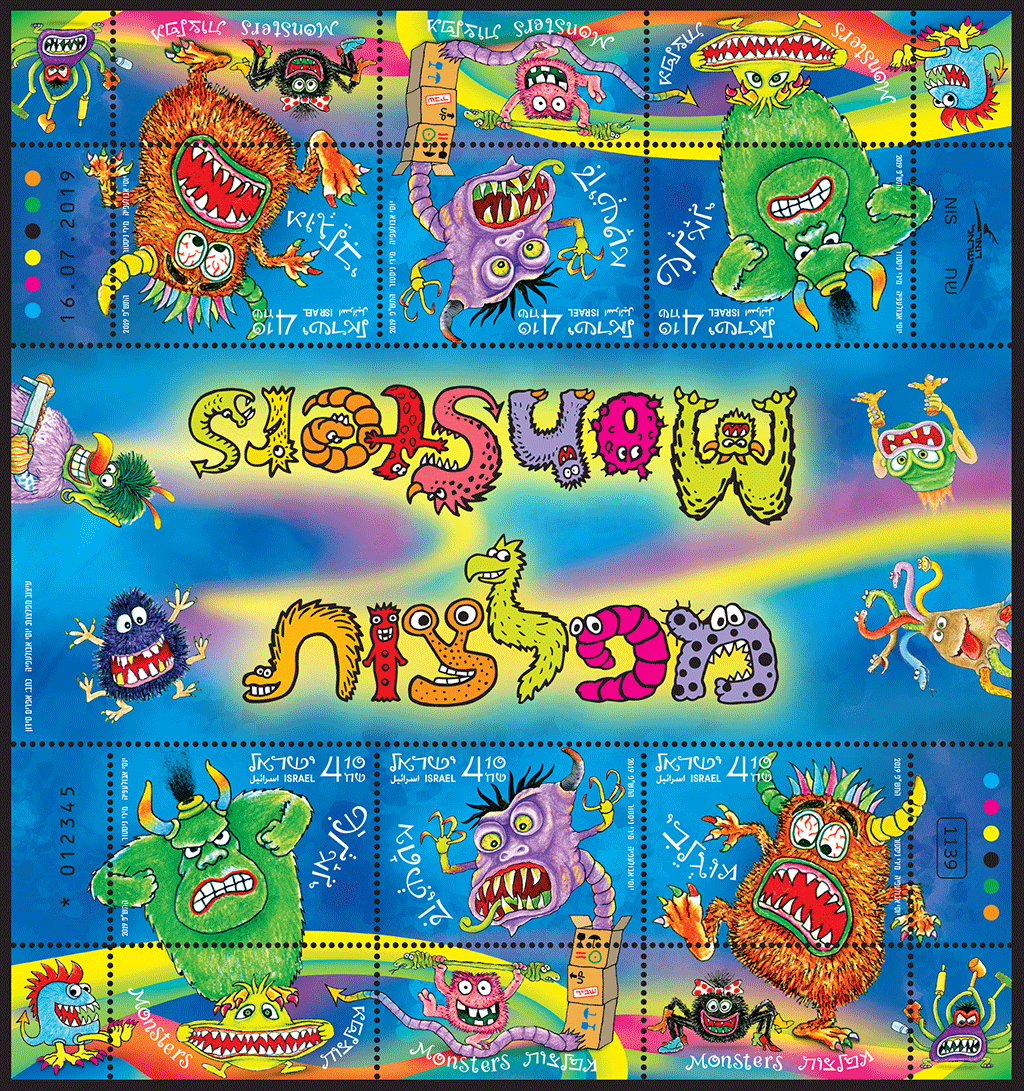
Monsters have been part of human lure throughout history. They arouse our fears as well as our curiosity. Monsters are found in Greek and Indian mythology, in China and Japan, among the Vikings and African tribes, as well as the Biblical Nephili and Og king of Bashan and the Golem from Prague in Jewish folklore.
These monsters symbolize the fear of the unknown, which is especially prevalent in young children. At this age anxiety and thoughts turn into terrible creatures hiding in the room, under the bed or in the closet which may come out of hiding at night and cause harm. Every parent experiences his/her child’s fear of these “monsters” and their real fear of them, most commonly at bedtime. This fear can persist for many months.
The monsters featured in this stamp series, created by illustrator Yossi Abulafia and author Ephraim Sidon, are an attempt to deal with these fears by presenting the monsters as funny clumsy characters that, despite their frightening and threatening appearance, are actually good creatures that just want to be loved, encouraged and have friends like everyone else. Thus, this stamp series joins the current trend in children’s literature to “humanize” monsters in order to neutralize the fear they instill in the young.
Like the monsters in Where the Wild Things Are, There’s a Nightmare in my Closet and the Shrek movies, the inhabitants of the Monsters Garden are seemingly frightening and intimidating. But outward appearances can be deceiving. These creatures believe they are beautiful, clever and talented, and they especially crave children’s love. And in fact, the enthusiastic response from tens of thousands of children upon meeting these monsters proves that fear can indeed be conquered through humor.
Muglevi (Cowardly Heart)
Muglevi is a lonely monster with no family or home. He develops many fears, such as a fear of heights, lows, closed spaces, open spaces, public singing, root vegetables, stage fright and fear fright. And he is especially afraid of the monsters Akavishamish (Spider) and Mar-bitz (Hitter) that appear alongside him on each stamp. But beware! If frightened, Muglevi grows to be 4.68 meters tall, weighing 4.72 tons, he bears his teeth and claws and… and… faints.
Kishta (Go Away)
This is Kishta… and if you ask her this question: Why do you have such fingernails and why are you so scary?” she will give you an angry look and reply: Why do you care – it’s none of your business. Go away, just go away from here! I don’t want to see you.
And she mostly wants Kadmoni, the monster that follows her everywhere, to go away…
Sanani (Hater)
Sanani mostly hates everything! But you can’t blame him, after his difficult childhood. He was the fifth child in a family that only had two children. His mother died three years before he was born and when he was just two days old, he was sent off to hunt turnips.
Thus, he hates heartily and there are things he doesn’t like. He even hates the other monsters that are constantly by his side.
—Ephraim Sidon
The stamp series was inspired by the Monsters exhibit at the Eretz Israel Museum (Initiative and artistic management: Zachi Becker) which was designed and written by Yossi Abulafia and Ephraim Sidon. Also inspired by the book “The Monsters Garden” by Ephraim Sidon and Yossi Abulafia.
This stamp sheet was produced using hexachrome (6-color) printing.
Technical Specifications:
Denominations:NIS 4.10
Size of Booklet: W: 30 mm H: 40
Plate nos.: 1139
Designers: Yossi Abulafia & Miri Nistor
Printers: Enschede, Netherland
Printing method: Offset
Sheet type: Special & small decorated sheet
No. of stamps in sheet: 6 (6 tabs)
Place of cancellation: Tel Aviv – Yafo
No. of FDCs: 1
Price of FDCs: NIS 13.50
Place of cancellation: Tel Aviv – Yafo
Special comments: This stamp sheet was produced using hexachrome (6-color) printing.
Ethnic Festivals in Israel: The Sigd Festival
Issue Date: November 26
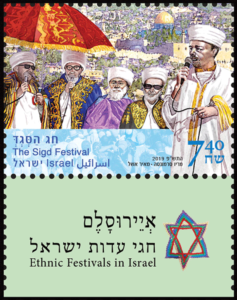 When the State of Israel was founded and its gates were opened to Jews from around the world, the wave of Olim (new immigrants) which had been rising since the end of the 19th century became a virtual flood. Entire communities from around the globe gathered their belongings and made their way to the Land of their ancestors. Each community brought its customary garb, special language, traditions and all of the other cultural components it had developed over centuries in the Diaspora.
When the State of Israel was founded and its gates were opened to Jews from around the world, the wave of Olim (new immigrants) which had been rising since the end of the 19th century became a virtual flood. Entire communities from around the globe gathered their belongings and made their way to the Land of their ancestors. Each community brought its customary garb, special language, traditions and all of the other cultural components it had developed over centuries in the Diaspora.
In the early years of the State, Israel’s leaders had to cope with the huge challenge of formulating a new society, one that would incorporate people from Jewish communities around the globe. As part of the “melting pot” concept the new immigrants were expected to abandon the traditions they brought from their native lands and embrace the image and traditions of the new Israeli. This attitude changed over the years and was replaced by one that honored and cherished the immense cultural wealth brought by the Olim. Israeli cuisine adopted diverse flavors and foods originating around the world, Israeli music enriched its work with a broad range of tones and the Israeli calendar integrated holidays and festivals celebrated by the different ethnic groups. Some of these festivals have spread beyond their original ethnicity and are celebrated by Israeli society as a whole.
The Sigd Festival
The Sigd Festival is unique to Ethiopian Jewry and is celebrated each year on the Hebrew date of 29th Heshvan, 50 days after Yom Kippur. In addition to the name Sigd (which stems from the Hebrew word Sgida, meaning worship) it is also called the “festival of supplication” and the “annual gathering”. It is a day of fasting and purification, including a ceremony to renew the covenant between the people and God and a prayer to return to Jerusalem.
The Sigd ceremony is based on the detailed description of the renewal of the covenant conducted in Jerusalem by Ezra and Nehemiah upon the return to Zion (Nehemiah chapters 8-10). It was customary in Ethiopia to hold the ceremony atop a high mountain, symbolizing Mount Sinai. On the eve of the festival, participants would gather at the foot of the mountain selected for the ceremony and purify themselves. Early in the morning they prepared food that would be served at the end of the fast day. On the morning of the Sigd, participants gathered dressed in their best clothes and ascended the mountain together, carrying the Ethiopian Torah (Orit). At the summit of the mountain, the Kess (priests) led prayers praising God, expressing repentance, requesting forgiveness and longing for Jerusalem. They read the Ten Commandments, chapter 9 from the Book of Nehemiah, blessings and curses to the gathered worshippers. At the end of the ceremony, the participants confessed their sins and expressed their desire to celebrate the following year in Jerusalem. The journey back down the mountain was joyous, filled with singing and dancing, and the day concluded with a banquet to break the fast.
When the Jews of Ethiopia made Aliyah to Israel, it was decided that the Sigd would continue to be celebrated annually in Jerusalem. The Sherover Promenade in Jerusalem, which overlooks the Temple Mount, was chosen as the site for the event and it is there that the members of the Ethiopian community gather. In addition to the prayer ceremony conducted by the Kess priests, the festive gathering itself is considered to be significant.
Description of the Stamp
• Background photo of Jerusalem, photo of the Kess priests and photo of the participants celebrating: Gidon Agaza.
• Photo of the Star of David on the stamp tab – courtesy of Elmaz Art in Israel.
• With thanks to the Association of Ethiopian Jews for their help in preparing the stamp and the text. This is the third in a series of three stamps, including those featuring the Sehrane and Mimouna festivals, which were issued earlier this year.
Technical Specifications:
Size of stamps: W: 40 mm, H: 30 mm
Face Value: NIS 7.40
Plate Block No.: 1140
Designer: Mario Sermoneta & Meir Eshel
Printing Method: Offset
Printer: Enschede, Netherland
Sheet Type: Regular
Stamps per sheet: 15
Tabs: 5
No. of FDC’s: 1
Price of FDC’s: NIS 8.60
Place of cancellation: Jerusalem
Israeli Board Games (Israel 2019)
Issue Date: November 26th
TAKI
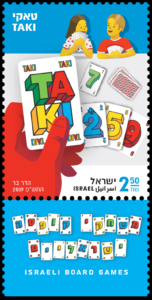 Since it was first introduced in 1983, TAKI has become one of the most popular board games in Israel and one of the greatest symbols of the “togetherness” culture.
Since it was first introduced in 1983, TAKI has become one of the most popular board games in Israel and one of the greatest symbols of the “togetherness” culture.
The game, whose name means “waterfall” in Japanese and is illustrated by designer Ari Ron, incorporates luck and strategy in just the right amounts for the whole family.
What makes a game so much fun? There are a number of essential components, and they can even be listed in order of significance, but as with any creation, from a stunning cake to a fascinating story or moving piece of music, there is always an elusive component that is hard to define and without which, perfection would not be attained – without it there is no magic.
Haim Shafir, who invented TAKI, says that the secret to the game’s success lies in the slogan that expresses his creative vision – Simply be Happy Together, “because that is the true purpose of board games, and essentially – of life itself”.
—Haim Shafir
Rummikub®
Rummikub, an original Israeli produced game, is one of the top three family games in the world. It is currently Israel’s number one export, sold to 59 countries and translated into 26 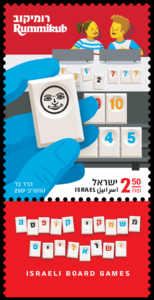 languages! A new Rummikub game is manufactured every six seconds.
languages! A new Rummikub game is manufactured every six seconds.
According to estimates, there is not a single home in Israel that does not have a Rummikub game, whether it is the prestigious version with marblelike tiles in a wooden box, the lightweight travel version, in the metal gift box and more…
How is the game played? Each player takes 14 tiles and tries to be the first to use all the tiles from his/her rack by creating groups or series and by maneuvering.
If you are lucky enough to draw the joker tile – use it wisely, because it can replace any number!
The game was developed in the 1950’s by the late Ephraim Hertzano and manufactured by Kodkod. Ephraim couldn’t have imagined that his social invention would one day change free time for families and children around the world.
Rummikub was declared to be one of the best games of the 20th century.
The World Rummikub Championships have been held since 1991, with participants from approximately 36 different countries.
The popular online Rummikub app has been downloaded by millions worldwide, allowing users to play with others online.
—Mariana and Micha Hertzano, CEO
The items on the stamps courtesy of Shafir Games and Kodkod company ©.
TAKI & Rummikub
Date of Issue: 26 November, 2019
Size of stamps: W: 30 mm, H: 40 mm
Face Value: NIS 2.50, 2.50, 2.50
Plate Block No.: 1137
Designer: Hadar Bar
Printing Method: Offset
Printer: Enschede, Netherland
Sheet Type: Regular
Stamps per sheet: 15
Tabs: 5
No. of FDCís: 1
Price of FDC’s: NIS 6.20
Place of cancellation: Tel Aviv – Yafo
[press release]
Weizmann Institute of Science 70th Anniversary
Issue Date: November 26, 2019
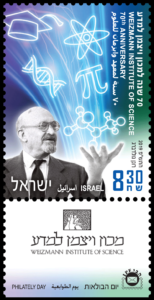 The Weizmann Institute of Science has been guiding the spirit and substance of the State of Israel for 70 years. Dr. Chaim Weizmann, the first president of Israel and founder of the Weizmann Institute of Science is quoted in the campus square: “I trust and feel sure in my heart that science will bring to this land both peace and a renewal of its youth, creating here the springs of a new spiritual and material life. […] I speak of both science for its own sake, and science as a means to an end.” And in fact, 70 years after its founding ceremony, attended by the leaders of the young nation on November 2, 1949, the Weizmann Institute of Science is today ranked third in the world for research quality (Nature Index 2019 ranking) and is among the world’s 25 most influential institutions for technological and medical application. This is an especially significant achievement, as the Institute’s scientists focus on basic research, motivated solely by curiosity that has a single goal: to expand the boundaries of human knowledge and better understand the world and our place in it.
The Weizmann Institute of Science has been guiding the spirit and substance of the State of Israel for 70 years. Dr. Chaim Weizmann, the first president of Israel and founder of the Weizmann Institute of Science is quoted in the campus square: “I trust and feel sure in my heart that science will bring to this land both peace and a renewal of its youth, creating here the springs of a new spiritual and material life. […] I speak of both science for its own sake, and science as a means to an end.” And in fact, 70 years after its founding ceremony, attended by the leaders of the young nation on November 2, 1949, the Weizmann Institute of Science is today ranked third in the world for research quality (Nature Index 2019 ranking) and is among the world’s 25 most influential institutions for technological and medical application. This is an especially significant achievement, as the Institute’s scientists focus on basic research, motivated solely by curiosity that has a single goal: to expand the boundaries of human knowledge and better understand the world and our place in it.
Weizmann scientists were the first to study cancer in Israel, the first to build an electronic computer (in 1954), the first to develop amniocentesis and the first original Israeli drug (Copaxone, for the treatment of multiple sclerosis). The first three particle accelerators in Israel were operated at the Institute and advanced ways to utilize solar energy were studied and developed in its solar dele tower. Prof. Ada Yonath, who deciphered the 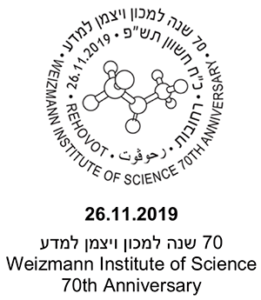 structure and workings of the ribosome, the cell’s protein factory, was the first female Israeli scientist to be awarded the Nobel Prize (2009). Today the Institute is a leader in developing personalized medical treatment, aerospace research and quantum physics.
structure and workings of the ribosome, the cell’s protein factory, was the first female Israeli scientist to be awarded the Nobel Prize (2009). Today the Institute is a leader in developing personalized medical treatment, aerospace research and quantum physics.
The Weizmann Institute of Science also contributes in the social and educational realms. The “Perach” tutorial project was started at the Institute in the 1970’s. The national Science Oriented Youth program also began here. The expanded program is now managed by the Davidson Institute of Science Education, the educational branch of Weizmann Institute of Science. Thus the Institute’s scientists continue to lay the foundation of Israel’s status as the “startup nation”, as well as narrowing social gaps and working to improve the overall welfare of humankind.
—Yivsam Azgad
Description of the Stamp
The symbols rising from Dr. Chaim Weizmann’s hand represent the various fields of research at the Weizmann Institute of Science:
The symbols’ upward movement symbolizes the future.
Images of Dr. Chaim Weizmann on the stamp and FDC: courtesy of the National Photo Collection.
The FDC features a photo of the Weizmann Institute of Science Jacob Ziskind Building, the Institute’s first building. The inaugural ceremony was held here on November 2, 1949, attended by Dr. Chaim Weizmann and Prime Minister David Ben Gurion. The WEIZAC, 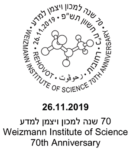 Israel’s first computer, was constructed in this building. Today, the Jacob Ziskind Building houses the Faculty of Mathematics and Computer Science. Photo courtesy of Weizmann Institute of Science.
Israel’s first computer, was constructed in this building. Today, the Jacob Ziskind Building houses the Faculty of Mathematics and Computer Science. Photo courtesy of Weizmann Institute of Science.
The cancellation [right] features an acetone molecule.
Name of stamp/set: Weizmann Institute of Science 70th Anniversary
Date of Issue: 26 November, 2019
Size of stamps\ souvenir sheet: W: 30 mm, H: 40 mm
Face Value: NIS 8.30
Plate Block No.: 1136
Designer: Ronen Goldberg
Printing Method: Offset
Printer: Enschede, Netherland
Sheet Type: Regular
Stamps per sheet: 15
Tabs: 5
No. of FDC’s: 1
Price of FDC’s: NIS 9.50
Place of cancellation: Rehovot
 Dassault Mirage IIICj
Dassault Mirage IIICj
Date of Issue: 01 May 2019
Denominations: Set of 6 – see table below
Size of Stamps: 30 x 54 mm
Plate nos.: No plate number
Designer: Yigal Gabay, Ben Kashels
Printers: Tadbik
Printing method: Flexo Digital
No. of FDCs: 1
Price of FDCs: NIS 3.70
Cancellation: Haifa -220
A-4H Skyhawk
Date of Issue: 01 May 2019
Denominations: Set of 6 – see table below
Size of Stamps: 30 x 54 mm
Plate nos.: 1102
Designer: Yigal Gabay, Ben Kashles
Printers: Tadbik
Printing method: Flexo Digital
No. of FDCs: 1
Price of FDCs: NIS 3.70
Cancellation: Afula ATM Rates:
ATM Rates:
Inland letter up to 50g: NIS 2.50
Inland thick letter up to 50g: NIS 4.10
Airmail group 1 up to 100g (USA): NIS 8.30
Airmail group 2 up to 100g (Canada): NIS 9.00
Airmail group 3 up to 100g (Mainly Europe): NIS 7.40
Airmail group 4 up to 100g (Eastern Europe): NIS 6.50
Set of 6 ATM labels: NIS 37.80
Israel’s May 2019 Issues:
Click on the issue names to go the specific pages.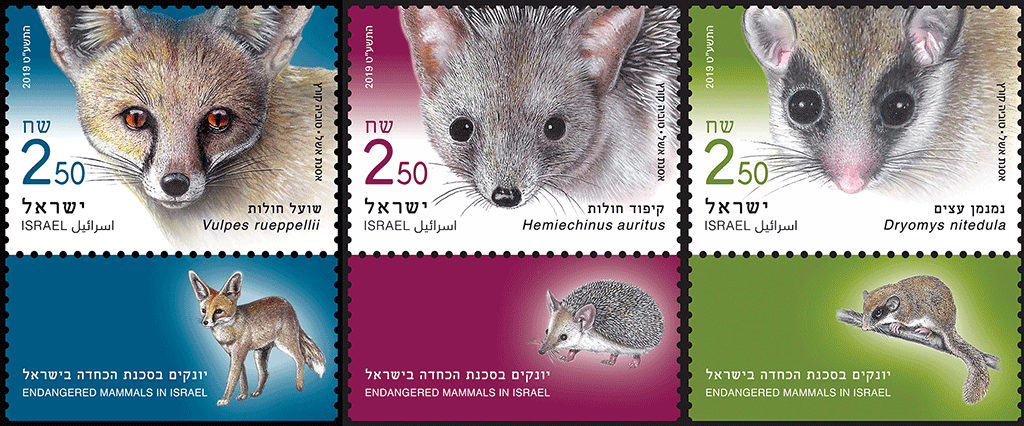
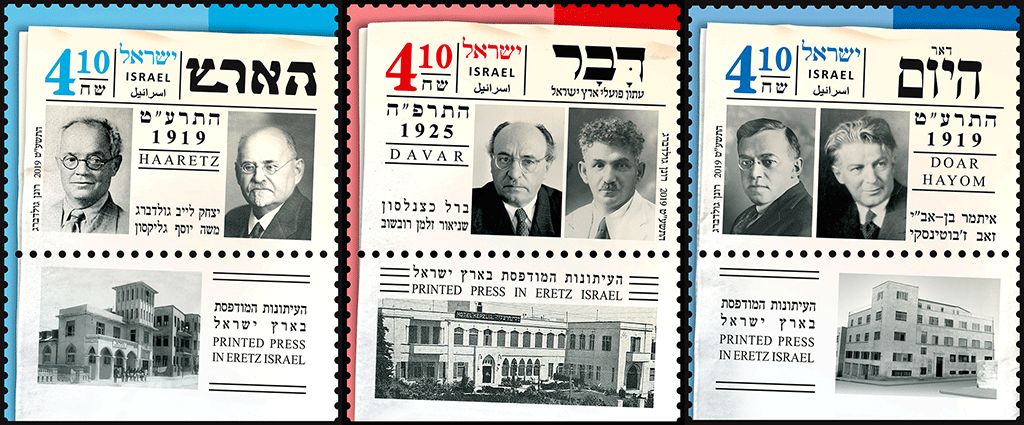
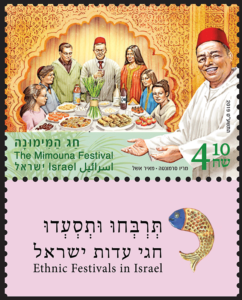
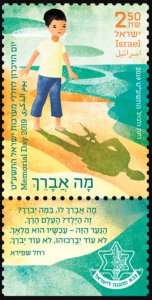
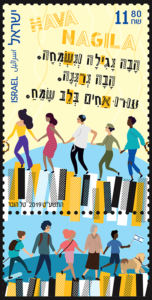
 Three stamps: Vulpes rueppellii, Hemiechinus auritus, Dryomys nitedula
Three stamps: Vulpes rueppellii, Hemiechinus auritus, Dryomys nitedula
Date of Issue: 01 May 2019
Denominations: NIS 2.50,2.50,2.50
Size of Stamps: W: 40 mm H: 30 mm
Plate nos.: 1119
Designers: Tuvia Kurtz, Osnat Eshel
Printers: Cartor Security Printing, France
Printing method: Offset
Sheet type: Mini Special Sheet
No. of stamps in sheet: 9 (3 tabs)
Place of cancellation: Be’er Sheva
No. of FDCs: 1
Price of FDCs: NIS 8.70
From Israeli Post:
Three special mammal species in Israel have something in common – although each lives 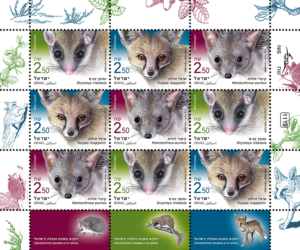 in a different area and habitat. All of these habitats are disappearing, be it loess covered areas, desert sands in the Negev or Mediterranean forests. The destruction of natural habitats is the most severe problem plaguing our world’s wildlife, and Israel is no exception.
in a different area and habitat. All of these habitats are disappearing, be it loess covered areas, desert sands in the Negev or Mediterranean forests. The destruction of natural habitats is the most severe problem plaguing our world’s wildlife, and Israel is no exception.
Wide open spaces that existed just 200 years ago have been populated. Fallow fields have become few and planted. The “wilderness” has been tamed by concrete and cement and crisscrossed by roads. All of these factors have contributed to the decrease and segmentation of natural habitats, making it difficult for wild animals in Israel to sustain their populations.
These three species are all nocturnal, thus they are seldom seen by humans, who may admire their beauty only for brief moments. They will cease to exist if we fail to make a 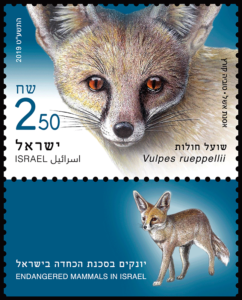 special effort to preserve them and their habitats.
special effort to preserve them and their habitats.
Rueppell’s Fox — Vulpes rueppellii
The Rueppell’s Fox is a small, beautiful species. It has a grey stripe running from the corner of its eye to its mouth and paws that are covered in fur as an adaptation to its sandy habitat. The Negev Desert is the northernmost distribution area of this species. In the 1980’s the population gradually disappeared from the sands of the Negev and Arava, due to the destruction from its displacement of its habitat by red foxes and wolves.
Forest Doormouse — Dryomys nitedula
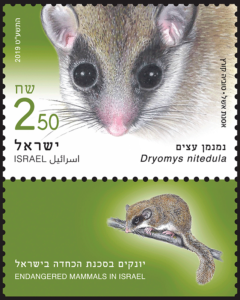 The Forest Doormouse is a small, stealth rodent that is active at night and few ever see it. It has a black “mask” on its face and a long, bushy tail. This species builds round nests in treetops, and spends its days sleeping there. At night it searches for acorns from oak trees and fruit in its
The Forest Doormouse is a small, stealth rodent that is active at night and few ever see it. It has a black “mask” on its face and a long, bushy tail. This species builds round nests in treetops, and spends its days sleeping there. At night it searches for acorns from oak trees and fruit in its
wooded Mediterranean habitat, using birds’ nests like tables. The Forest Doormouse may be found in the Galilee and was recently also seen in Jojoba groves in the northern Negev Desert. It is prevalent in the Balkans and southward to Israel, through Syria and Lebanon. Israel is the southernmost edge of its distribution.
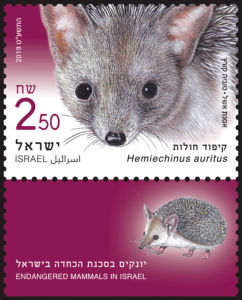 Long-eared Hedgehog — Hemiechinus auritus
Long-eared Hedgehog — Hemiechinus auritus
The Long-eared Hedgehog is the smallest hedgehog species in Israel. It has a light colored face, a pointed nose, large furless ears and no fur. It lives on the coastal plain as far as Caesarea in the north, in areas of loess sediment. There is an isolated population in the Golan Heights as well. The Long-eared Hedgehog may also be found in towns in the central of Israel, where it shares the urban habitat with Southern White-breasted Hedgehog.
—Keren Or
Zoologist, Zoological Center, Ramat Gan
 Date of Issue: 01 May 2019
Date of Issue: 01 May 2019
Denomination: NIS 4.10
Size of Stamp: W: 40 mm H: 30
Plate no.: 1120
Designers: Mario Sermonte, Meir Eshel
Printers: Cartor Security Printing, France
Printing method: Offset
Sheet type: Mini Special Sheet (Teth Besh Sheet)
No. of stamps in sheet: 8 (8 tabs)
Place of cancellation: Jerusalem
No. of FDCs: 1
Price of FDCs: NIS 5.30
From Israel Post:
When the State of Israel was founded and its gates were opened to Jews from around the world, the wave of Olim (new immigrants) which had been rising since the end of the 19th century became a virtual flood. Entire communities from around the globe gathered their belongings and made their way to the Land of their ancestors. Each community brought its customary garb, special language, traditions and all of the other cultural components it had developed over centuries in the Diaspora.
In the early years of the State, Israel’s leaders had to cope with the huge challenge of formulating a new society, one that would incorporate people from Jewish communities around the globe. As part of the “melting pot” concept the new immigrants were expected to abandon the traditions they brought from their native lands and embrace the image and traditions of the new Israeli. This attitude changed over the years and was replaced by one that honored and cherished the immense cultural wealth brought by the Olim. Israeli cuisine adopted diverse flavors and foods originating around the world, Israeli music enriched its work with a broad range of tones and the Israeli calendar integrated holidays and festivals celebrated by the different ethnic groups. Some of these festivals have spread beyond their original ethnicity and are celebrated by Israeli society as a whole.
The Mimouna Festival
 The Mimouna festival stems from the Jewish community in Morocco and is celebrated in the evening of the last day of Passover. The Mimouna is meant to unify the Jewish community and its essence is the opening of homes and hearts to all who wish to join in the celebration. It is customary to open one’s door as a sign that all are welcome – family, neighbors, acquaintances and strangers alike.
The Mimouna festival stems from the Jewish community in Morocco and is celebrated in the evening of the last day of Passover. The Mimouna is meant to unify the Jewish community and its essence is the opening of homes and hearts to all who wish to join in the celebration. It is customary to open one’s door as a sign that all are welcome – family, neighbors, acquaintances and strangers alike.
The hosts make every effort to provide their guests with an enjoyable experience. They are received with a traditional greeting: Tirbachu Utis’adu which wishes them success and good fortune. Participants wear splendid traditional garb, including golden robes and colorful head- coverings. The gathering is accompanied by music, singing and dancing.
The hosts traditionally serve a lavish and diverse array of delicacies and sweets, most of which are prepared during the days of Passover. These dishes are made with ingredients that are strictly kosher for Passover. Also served is the traditional Mufleta, which is made of dough and prepared at the end of the holiday, just before being served to the guests.
The festive atmosphere continues the next morning, and it is customary to spend the day outside with family and friends.
After coming to Israel, the Moroccan community continued to celebrate the festival within itself and in 1965 the tradition was established in the format of mass celebrations for the general public. The Mimouna festival has acquired a place of honor among Israelis and is celebrated each year by most people.
Description of the Stamp
Photos of the gate, the doors and the plant – Shutterstock.
Photo of the fish – Pnina Barkay.
Photos of the host’s clothing and hat and the photo that inspired the family – courtesy of the World Federation of Moroccan Jewry.
With thanks to the World Federation of Moroccan Jewry.
This is the first in a series of three stamps. Two additional stamps featuring the Sehrane and Sigd festivals will be issued later this year.
 Date of Issue: 01: May: 2019
Date of Issue: 01: May: 2019
Size of stamps: W: 30.mm H: 40 mm
Face Value: NIS 2.50:
Plate Block No.: 1114
Designer: Rinat Gilboa
Printing Method: Offset
Printer: Cartor Security Printing, France
Sheet Type: Regular
Stamps per sheet: 15
Tabs: 5
No. of FDCs: 1
Price of FDC’s: NIS 3.70
Place of cancellation: Jerusalem
From Israel Post:
The letter card, cover and stamp – all of which are special and unique to Memorial Day – constitute the basis of a sensitive, original and extraordinary tradition that came into being following the War of Independence.
Since Memorial Day 1952, a long line of Presidents, Prime Ministers and Ministers of Defense have signed personal letters to bereaved families of the fallen and Israel’s premier  artists take part in designing the covers and stamps for this commemorative day. Thus, from year to year, an unprecedented tradition has formed which, over time, has become one of the most recognized and extraordinary ambassadors of Israel’s commemorative culture.
artists take part in designing the covers and stamps for this commemorative day. Thus, from year to year, an unprecedented tradition has formed which, over time, has become one of the most recognized and extraordinary ambassadors of Israel’s commemorative culture.
(From: “Dear Families” published by the Ministry of Defense, on the occasion of Israel’s 50th Anniversary)
Over the years, the graphic design of the annual Memorial Day stamp has included symbolic expressions and monuments, and in recent years, also commemorative poems.
This stamp reflects the song Mah Avarech (How Shall I Bless Him) by Rachel Shapira.
What blessings can I give this child,
what can he be blessed with?
This boy is now an angel.
No one will bless him, he will be blessed no more.
© All rights reserved by the songwriter and ACUM. (Free translation from the original Hebrew)


